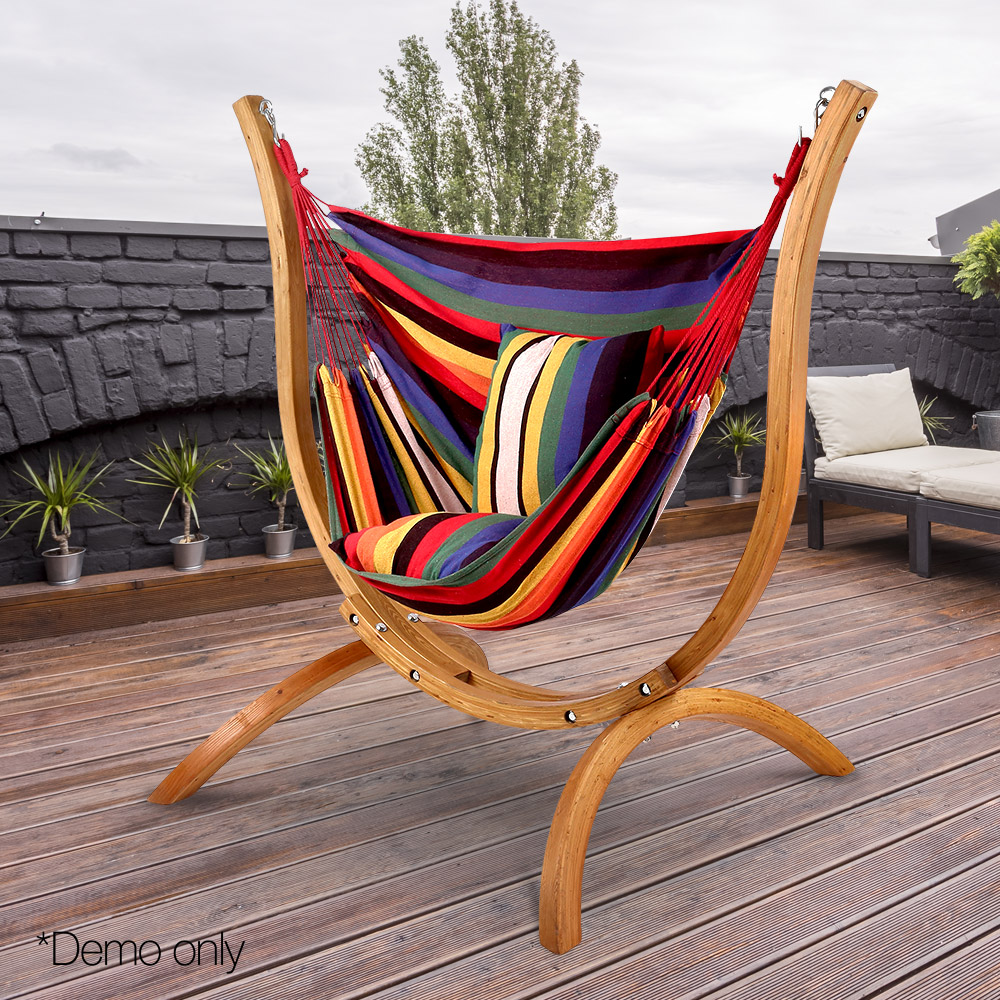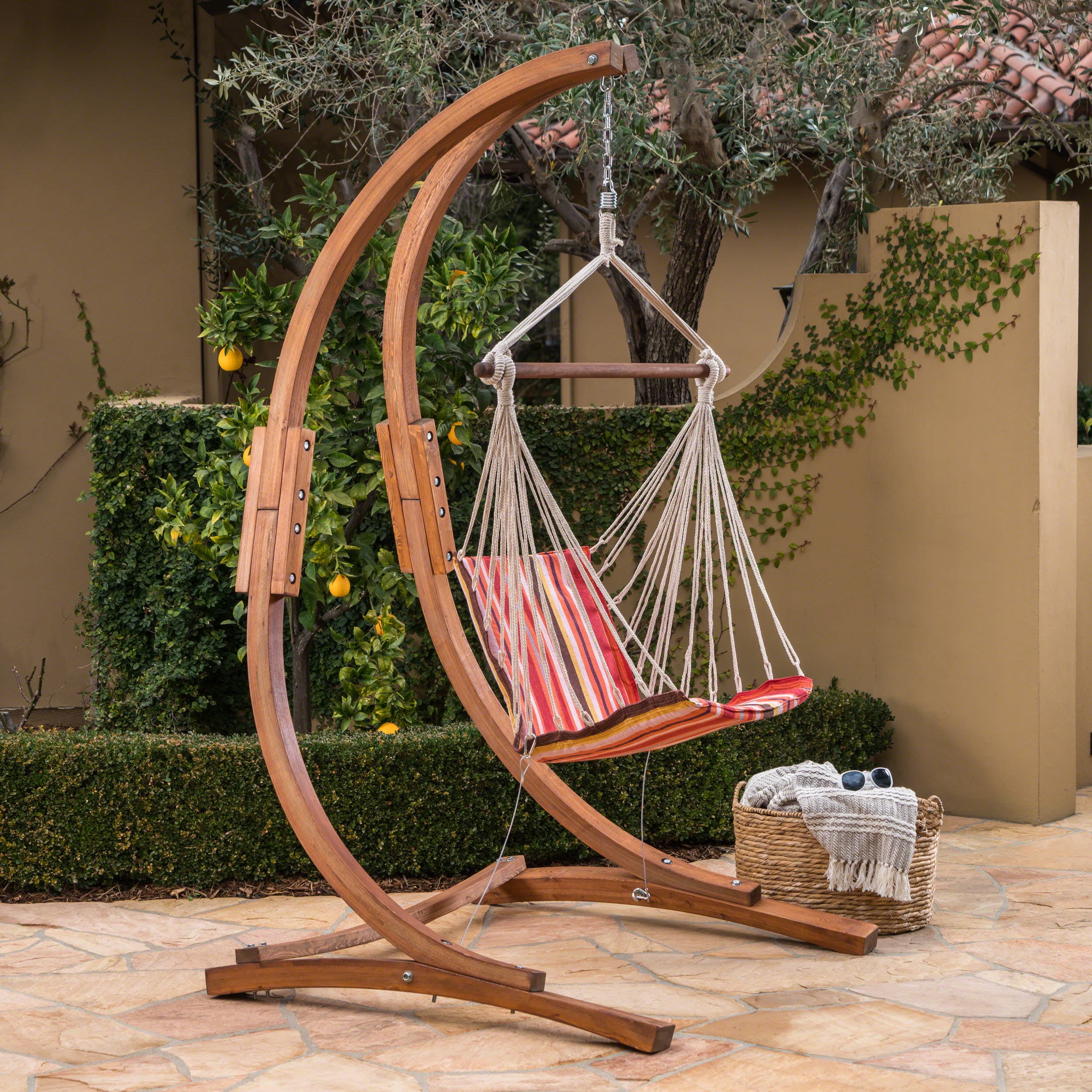Understanding Wooden Hammock Chair Frames

A wooden hammock chair frame is the foundation of your relaxing haven, offering a sturdy and stylish platform for your hammock chair. Choosing the right frame is crucial, as it determines both the comfort and durability of your chair.
Types of Wooden Hammock Chair Frames
There are several common types of wooden hammock chair frames, each with its own unique characteristics and benefits.
- A-Frame: This classic design resembles a traditional A-frame tent, providing a stable and secure base for your hammock chair. The two legs spread apart, offering a wide base for stability, while the top bar supports the hammock. A-frames are often made from sturdy wood like cedar or oak, making them durable and long-lasting.
- Swing Frame: This frame features a single, curved or straight bar suspended from a sturdy stand. This design provides a gentle rocking motion, adding a playful element to your relaxation. Swing frames are typically made from lighter woods like pine or spruce, making them easier to move around.
- Stand-Alone: This frame consists of a single, freestanding post with a curved or straight bar extending out to support the hammock. Stand-alone frames offer a minimalist aesthetic and are perfect for smaller spaces. They are often made from hardwoods like teak or mahogany, known for their strength and resistance to weathering.
Advantages and Disadvantages of Each Frame Type
- A-Frame:
- Advantages: Provides excellent stability, suitable for heavier hammocks, typically more durable due to the sturdy design.
- Disadvantages: Can be bulky and take up more space, may require more assembly, potentially heavier to move.
- Swing Frame:
- Advantages: Offers a gentle rocking motion, often lighter and easier to move, can be more aesthetically pleasing with its minimalist design.
- Disadvantages: May not be as stable as A-frames, may not be suitable for heavier hammocks, potentially less durable due to lighter wood used.
- Stand-Alone:
- Advantages: Compact and space-saving, often made from weather-resistant hardwoods, adds a modern touch to your outdoor space.
- Disadvantages: May not be as stable as A-frames, can be more expensive, limited in weight capacity.
Wood Species Commonly Used for Hammock Chair Frames
The type of wood used for your hammock chair frame plays a significant role in its durability, aesthetics, and cost. Some popular wood species include:
- Cedar: Known for its natural resistance to rot and insects, cedar is a durable and aromatic wood that adds a warm, rustic touch. It is also relatively affordable.
- Oak: A strong and durable hardwood, oak is resistant to wear and tear, making it a good choice for high-traffic areas. It offers a classic look and a rich, warm color.
- Pine: A softer wood, pine is lighter and more affordable than hardwoods. It is commonly used for swing frames due to its ease of working with. However, pine is less durable and susceptible to damage.
- Teak: A dense and durable hardwood, teak is naturally resistant to weathering, insects, and decay. It is often used for outdoor furniture due to its long lifespan and beautiful golden hue. Teak is a premium choice, known for its durability and elegance.
- Mahogany: Another premium hardwood, mahogany is known for its rich red color and intricate grain patterns. It is strong and durable, making it a popular choice for high-end furniture. However, mahogany is a more expensive option.
Choosing the Right Wood for Your Hammock Chair Frame
When selecting wood for your hammock chair frame, consider the following factors:
- Durability: If you want a frame that will last for years, choose a hardwood like oak, teak, or mahogany. These woods are known for their strength and resistance to wear and tear.
- Aesthetics: Consider the look you want to achieve. Cedar offers a rustic charm, while teak and mahogany bring a more elegant touch. Pine provides a lighter and more casual feel.
- Budget: Pine and cedar are generally more affordable than hardwoods like teak and mahogany. Choose the wood that fits your budget and desired level of quality.
Building a Wooden Hammock Chair Frame

Creating a wooden hammock chair frame is a rewarding DIY project that allows you to personalize your outdoor space with a unique and comfortable seating option. This guide will walk you through the steps involved in building a sturdy and safe frame from scratch.
Materials and Tools
Before you begin, gather the necessary materials and tools to ensure a smooth construction process.
- Lumber: Choose durable hardwood like cedar, oak, or redwood for longevity and resistance to weathering. You’ll need four long pieces for the frame’s legs, two shorter pieces for the top and bottom rails, and additional pieces for the crossbars and supports.
- Fasteners: Use galvanized screws or bolts for secure connections, ensuring they are long enough to penetrate the wood adequately.
- Wood Glue: Apply wood glue to all joints for added strength and stability.
- Sandpaper: Smooth the surface of the wood after cutting and assembly to prevent splinters and enhance the finished look.
- Measuring Tape and Pencil: Precise measurements are crucial for a well-constructed frame.
- Saw: A circular saw or miter saw is ideal for accurate cuts.
- Drill: A drill with appropriate drill bits for pilot holes and driving screws.
- Level: Ensure the frame is level and stable for a safe and comfortable hammock chair.
- Clamps: Hold pieces together securely during assembly.
- Safety Gear: Wear safety glasses, gloves, and hearing protection when using power tools.
Cutting the Lumber, Wooden hammock chair frame
Wooden hammock chair frame – Precise cutting is essential for a well-constructed frame. Start by measuring and marking the lumber according to your design.
- Legs: Cut four pieces of lumber for the legs, ensuring they are all the same length. The length will determine the overall height of the hammock chair.
- Top and Bottom Rails: Cut two pieces of lumber for the top and bottom rails. The length of these pieces should be slightly longer than the distance between the legs.
- Crossbars: Cut two or more pieces of lumber for the crossbars, which will connect the legs and provide additional support. The length of the crossbars will depend on the width of the hammock chair.
- Supports: Cut additional pieces of lumber for supports, which will help to reinforce the frame and prevent sagging. The number and placement of supports will depend on the design and size of the hammock chair.
Assembling the Frame
Once the lumber is cut, you can begin assembling the frame.
- Connect the Legs: Use wood glue and screws to attach the legs to the top and bottom rails. Ensure the legs are positioned at a 90-degree angle to the rails and that the rails are parallel to each other.
- Add Crossbars: Attach the crossbars to the legs, ensuring they are spaced evenly and provide adequate support. Use wood glue and screws for a strong connection.
- Install Supports: Add the supports to the frame, securing them with wood glue and screws. Supports should be positioned to reinforce the frame and prevent sagging.
- Sand and Finish: After assembly, sand the frame thoroughly to remove any rough edges or splinters. You can then apply a sealant or paint to protect the wood from the elements and enhance its appearance.
Safety Tips
Building a sturdy and safe hammock chair frame is crucial. Here are some additional tips to ensure your frame is safe for use.
- Use High-Quality Lumber: Choose durable hardwood that can withstand the weight and stress of a hammock chair. Avoid using softwoods or lumber with knots, as they are more prone to breaking.
- Secure Connections: Use strong fasteners, such as galvanized screws or bolts, and apply wood glue to all joints for added strength and stability. Ensure the screws or bolts are long enough to penetrate the wood adequately.
- Check for Stability: After assembly, test the stability of the frame by gently rocking it back and forth. Ensure that all joints are secure and that the frame does not wobble or sag.
- Inspect Regularly: Periodically inspect the frame for signs of wear or damage. Replace any damaged or weakened components promptly to ensure the safety of the hammock chair.
The graceful curve of a wooden hammock chair frame invites you to relax, a gentle sway echoing the rhythm of the sea. Perhaps you’d like to build upon this foundation and craft a sturdy, sun-kissed diy wooden beach chair for your own personal oasis.
Whether it’s a hammock’s gentle embrace or a beach chair’s sturdy support, the beauty of handcrafted wooden furniture transcends seasons, offering a timeless connection to nature’s tranquility.
The sturdy wooden hammock chair frame, a testament to craftsmanship, beckons you to relax and unwind. Its gentle sway evokes a sense of tranquility, reminiscent of days spent by the sea. For a similar outdoor experience at a budget-friendly price, consider an aldi wooden deck chair , a simple yet comfortable addition to your patio.
Both options offer a haven of peace and relaxation, inviting you to embrace the serenity of nature.
